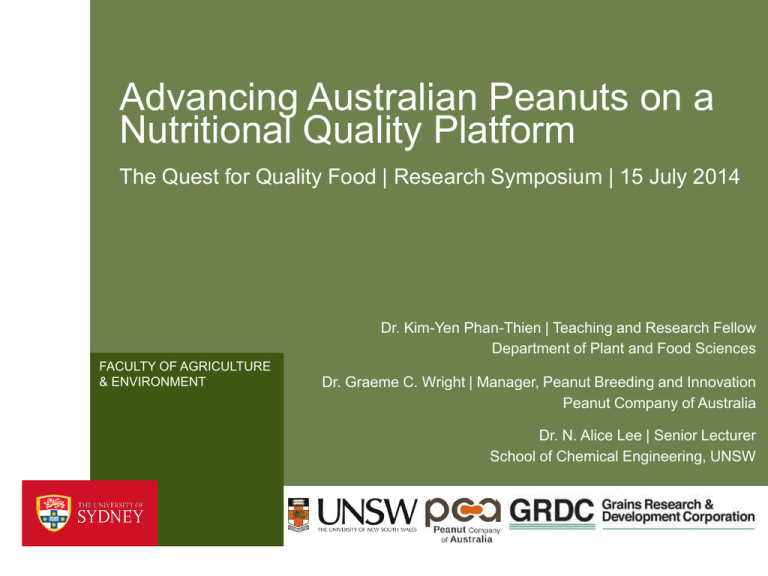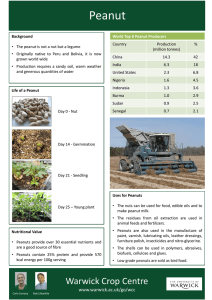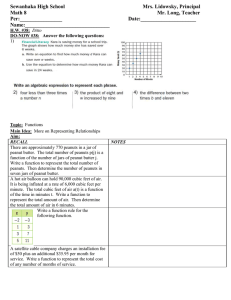Advancing Australian Peanuts on a Nutritional Quality Platform
advertisement

Advancing Australian Peanuts on a Nutritional Quality Platform The Quest for Quality Food | Research Symposium | 15 July 2014 Dr. Kim-Yen Phan-Thien | Teaching and Research Fellow Department of Plant and Food Sciences FACULTY OF AGRICULTURE & ENVIRONMENT Dr. Graeme C. Wright | Manager, Peanut Breeding and Innovation Peanut Company of Australia Dr. N. Alice Lee | Senior Lecturer School of Chemical Engineering, UNSW Advancing Australian Peanuts Agenda › Rise of health and nutrition marketing › The Australian peanut industry › Peanut genetics and breeding › Story 1: Development of Hi-Oleic peanuts › Story 2: Antioxidants – the next quality milestone in peanuts? › Conclusions 2 The Context Rising Importance of Nutrition & Health-Related Qualities in Food › Top 10 functional food trends - Health influenced the food purchase decisions of 64% of consumers, up from 61% in 2012 - 58% of consumers thought a lot about the healthfulness of their foods/beverages, 47% thought a lot about food ingredients, and 40% frequently turned their thoughts to food safety - Eight in 10 adults made some effort to eat healthier last year, and one-third (34%) made a lot of effort – behavior patterns that are unchanged over the past six years › Global functional food/beverage sales topped $118 billion in 2012 - “Ingredients added for special health benefits"•and "higher in nutrients" … the top two attributes that made a food product good for health and wellness Sloan (2014) Food Technology 68(4) 3 The Australian Peanut Industry Industry Snapshot › World peanut production 39.9 Mt (2012/13) - China, India & USA the main producers - USA is the dominant exporter & sets world prices › Australian production contributes 0.2% Atherton, -15°S - 11,300 ha yielding 26 kt (2.8 kt exported) - 5-8 kt imported mainly from China & Argentina › >95% Australian production in QLD - Severe droughts over past 2 decades have reduced production in Kingaroy - Large shift into irrigated regions esp. coastal Burnett Emerald Bundaberg Kingaroy, -27°S St George › PCA established 1924 as state marketing board and deregulated in 1992 – still the largest processor, marketer & supplier in Australia 4 The Australian Peanut Industry Peanut Breeding in Australia › Genetic improvement a key strategy to achieve production goals › Historical shift in emphasis of peanut breeding program since 1977 Sun Oleic 95R imported from USA - 1980s: yield and drought adaptation for dryland production - 1990s: yield and adaptation for increased irrigated production - Since 1995: yield and kernel quality - 2000s: earlier maturing varieties 5 Story 1: Hi-Oleic Peanuts What are Hi-Oleic Peanuts? Fatty Acid Composition… 100% 13 5 14 6 18 15 13 SATURATED POLYUNSATURATED 9 36 MONOUNSATURATED 28 61 62 24 25 SOYBEAN OIL CORN OIL 50% 82 77 58 54 0% HI OLEIC PEANUTS OLIVE OIL CANOLA OIL REGULAR PEANUTS Comparison of Fats Chart prepared by the Agronomy Department, Florida Cooperative Extension Service, Institute of Food and Agricultural Sciences, University of Florida (2003). 6 Story 1: Hi-Oleic Peanuts Benefits of Hi-Oleic Peanuts › Greater oil stability - Better shelf-life – less wastage - Less packaging requirements: no need for barrier packaging, pre-coating or stabilisers › Reduced oxidation - Less off-flavour development - Slower decline in roasted peanut flavour (esp. pyrazines) - Better tasting nuts for longer › Health benefits for consumers = marketing opportunity › Product differentiation from international ‘commodity grade’ peanuts 7 Story 1: Hi-Oleic Peanuts The R&D road to Hi-Oleic Peanuts › Trait identified by Uni. Florida in 1980s - Hi-Oleic trait is controlled by 2 recessive genes (‘ol1’ and ‘ol2’) › Introduced to Australia in 1990s - Conventional breeding to backcross Hi-Oleic mutant (F435) with adapted commercial Virginia lines e.g. Streeton, Conder - Selection for Hi-Oleic segregants in F2 initially done using gas chromatography on half a kernel so that remainder could still be planted for further generations - From mid-2000s NIRS calibrations developed to enable single seed selection › PCA has supplied 100% Hi-Oleic peanuts since 2002 - All new peanut variety releases from breeding program are Hi-Oleic - Quality assurance to maintain seed purity 8 Story 2: Antioxidant-Rich Peanuts Dietary Antioxidants and Human Health › Antioxidants may counteract oxidative damage to tissues and reduce risk of chronic degenerative diseases › Dietary antioxidant research frequently measures ‘total antioxidant capacity’ and phytochemical composition › Peanuts contain a wide range of antioxidants inc. phenolic acids, flavonoids, stilbenes, tocopherols 9 Story 2: Antioxidant-Rich Peanuts Australian R&D towards Antioxidant-Rich Peanuts › Australian peanut breeding lines phenotyped for antioxidant capacity - Genotypic variation: 25% RSD in ORAC (oxygen radical absorbance capacity assay) of 32 representative lines - G×E interaction: Relatively low G×E interaction suggests selection may be effective in different environments - Heritability: Moderate broad-sense heritability (genotype explained 44% phenotype on a plot basis and 82% on an entry mean basis) 10 Story 2: Antioxidant-Rich Peanuts Genetic Variation and Breeding Potential › Recombinant Inbred (RIL) population analysed for antioxidant capacity - Broad range in ORAC values that was normally distributed - Likely transgressive segregation beyond parental means › Further research - More work required to confirm heritability and G x E for the trait - Rapid, accurate and low cost phenotyping techniques are required to enable selection in larger segregating populations - Role of conjugated and matrix-bound antioxidants – implications for analysis but also bioavailability, bioactivity & functional food utility - Postharvest stability, processing effects, market & consumer research 11 Conclusions General Ideas for Australian Food Industries › The nutrition, health & wellness trend is a huge marketing opportunity - Use biomedical & clinical research to identify traits with substantiated health benefits - Input from market research to identify specific traits with commercial potential - Need to ensure marketing is an accurate portrayal of the science › Plant breeding to improve nutritional quality & value of primary products - Requires genetic variability for conventional breeding - Commercial viability requires simple, low cost, rapid phenotyping screen - Other strategies: enhancement by processing & fortification/supplementation › Interdisciplinary/collaborative approach for long-term success - Draw on University, DAFF and industry R&D capabilities to develop products that can be differentiated on a scientific basis – esp. genetic, biochemical - Collaborate to make the most of resources e.g. lab, pilot and commercial-scale R&D - Use interdisciplinary understanding to advantage e.g. plant physiology > agronomy > G×E > postharvest > bio-processing 12





